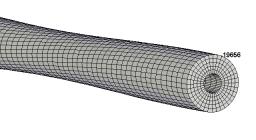Please let us keep the thread civil and on topic
Here are some factors that affect the rifle accuracy, If I missed anything, please comment.
1) Bullet Jump, and seating depth consistency
2) Bullet concentricity
3) Bullet BC consistency
4) Dynamic Bullet stability, ie. speed and twist rate
5) MV consistency, i.e., lower MV SD
6) Barrel pointing to the point of impact as MV varies
7) Barrel dilation/contraction at the time the bullet leaves the barrel.
8 ) Powder temperature stability
9 ) Case bullet/interface, i.e., neck tension
10) Muzzle crown shape or the lack of
11) Muzzle device, brake/suppressor
12) Chamber lead angle
13) Chamber throat length
14) Load ratio
15) Powder burning rate consistency vs temperature
16) Powder burning rate, i.e., fast/slow
17) Case capacity consistency
18) Muzzle pressure at the time when the bullet exit
19) Primer output consistency, initial pressure consistency
20) Total rifle weight and recoil
21) Trigger pull weight
22) Level of the rifle
23) Barrel/receiver interface, i.e., action trueing
24) Bolt/receiver interface, i.e., custom action
25) Receiver/stock interface, stock bedding
26) Rifle support, i.e., front rest, bipod, bench rest, rear rest, rear bags, etc
27) Aiming apparatus, i.e., Optics clarity, mechanical turrets consistency and stability under recoil
29) Shooter marksmanship
30) Wind call proficiency and consistency.
31) Case trim length uniformity and trim length
32) Case shoulder bump in case full sizing.
33) Free recoil, or no free recoil
34) Shooter/Gun interface shooter's fit and comfort behind the rifle
35) Barrel Profile, length, weight and material quality
36) Barrel bore rifling, its quality, quality lapping no lapping
37) Bullet Profile, VLD/ELD/RDF, LRHT, Flat base BT, HP, pointed, etc
38) Bullet caliber
39) G7 Form factor
40) Shooter's psychology, i.e., meditation/yoga before the match, caffeine level, Prozac intake and dosage, etc
41) Optics to receiver interface, i.e., Scope to rings contact. Rings to base, base to rifle contact.
43) Rifle to terra firma interface, i.e., shooting on wooden/concrete bench, shooting on solid surface, sand/grass land.
44) Shooting position, Standing, Kneeling, Prone. Supported/not supported, up/down, or upside down
45) Shooting induced stress, i.e. Anxiety about good score, wind calls, next shot, other shooters,
46) Shooting under the clock. That is, shooter focus vs speed
47) Shooter's health and physique, i.e. shooter age, fatigue, pain, and suffering
48) Shooter's anxiety such as worrying about house chores, wife, kids, ex-wife, significant other person, work load, etc
49) Optics Turret angular units, MOA/MIL 1/8 MOA vs 1/4 MOA, 0.05 semi-step
50) Distance to target: Range estimation, pre-known distance, scope estimation, LRF, LRF accuracy, LRF max effective range
51) Bullet speed in flight, i.e., supersonic, transonic, subsonic and dynamic stability.
52) Weather condition, i.e., other than wind, temp, station pressure, rain, fog, snow, mirage, etc.
53) Coriolis effect, that is, GPS location of the shooter and the direction of the shooting.
Here are some factors that affect the rifle accuracy, If I missed anything, please comment.
1) Bullet Jump, and seating depth consistency
2) Bullet concentricity
3) Bullet BC consistency
4) Dynamic Bullet stability, ie. speed and twist rate
5) MV consistency, i.e., lower MV SD
6) Barrel pointing to the point of impact as MV varies
7) Barrel dilation/contraction at the time the bullet leaves the barrel.
8 ) Powder temperature stability
9 ) Case bullet/interface, i.e., neck tension
10) Muzzle crown shape or the lack of
11) Muzzle device, brake/suppressor
12) Chamber lead angle
13) Chamber throat length
14) Load ratio
15) Powder burning rate consistency vs temperature
16) Powder burning rate, i.e., fast/slow
17) Case capacity consistency
18) Muzzle pressure at the time when the bullet exit
19) Primer output consistency, initial pressure consistency
20) Total rifle weight and recoil
21) Trigger pull weight
22) Level of the rifle
23) Barrel/receiver interface, i.e., action trueing
24) Bolt/receiver interface, i.e., custom action
25) Receiver/stock interface, stock bedding
26) Rifle support, i.e., front rest, bipod, bench rest, rear rest, rear bags, etc
27) Aiming apparatus, i.e., Optics clarity, mechanical turrets consistency and stability under recoil
29) Shooter marksmanship
30) Wind call proficiency and consistency.
31) Case trim length uniformity and trim length
32) Case shoulder bump in case full sizing.
33) Free recoil, or no free recoil
34) Shooter/Gun interface shooter's fit and comfort behind the rifle
35) Barrel Profile, length, weight and material quality
36) Barrel bore rifling, its quality, quality lapping no lapping
37) Bullet Profile, VLD/ELD/RDF, LRHT, Flat base BT, HP, pointed, etc
38) Bullet caliber
39) G7 Form factor
40) Shooter's psychology, i.e., meditation/yoga before the match, caffeine level, Prozac intake and dosage, etc
41) Optics to receiver interface, i.e., Scope to rings contact. Rings to base, base to rifle contact.
43) Rifle to terra firma interface, i.e., shooting on wooden/concrete bench, shooting on solid surface, sand/grass land.
44) Shooting position, Standing, Kneeling, Prone. Supported/not supported, up/down, or upside down
45) Shooting induced stress, i.e. Anxiety about good score, wind calls, next shot, other shooters,
46) Shooting under the clock. That is, shooter focus vs speed
47) Shooter's health and physique, i.e. shooter age, fatigue, pain, and suffering
48) Shooter's anxiety such as worrying about house chores, wife, kids, ex-wife, significant other person, work load, etc
49) Optics Turret angular units, MOA/MIL 1/8 MOA vs 1/4 MOA, 0.05 semi-step
50) Distance to target: Range estimation, pre-known distance, scope estimation, LRF, LRF accuracy, LRF max effective range
51) Bullet speed in flight, i.e., supersonic, transonic, subsonic and dynamic stability.
52) Weather condition, i.e., other than wind, temp, station pressure, rain, fog, snow, mirage, etc.
53) Coriolis effect, that is, GPS location of the shooter and the direction of the shooting.
Last edited:











